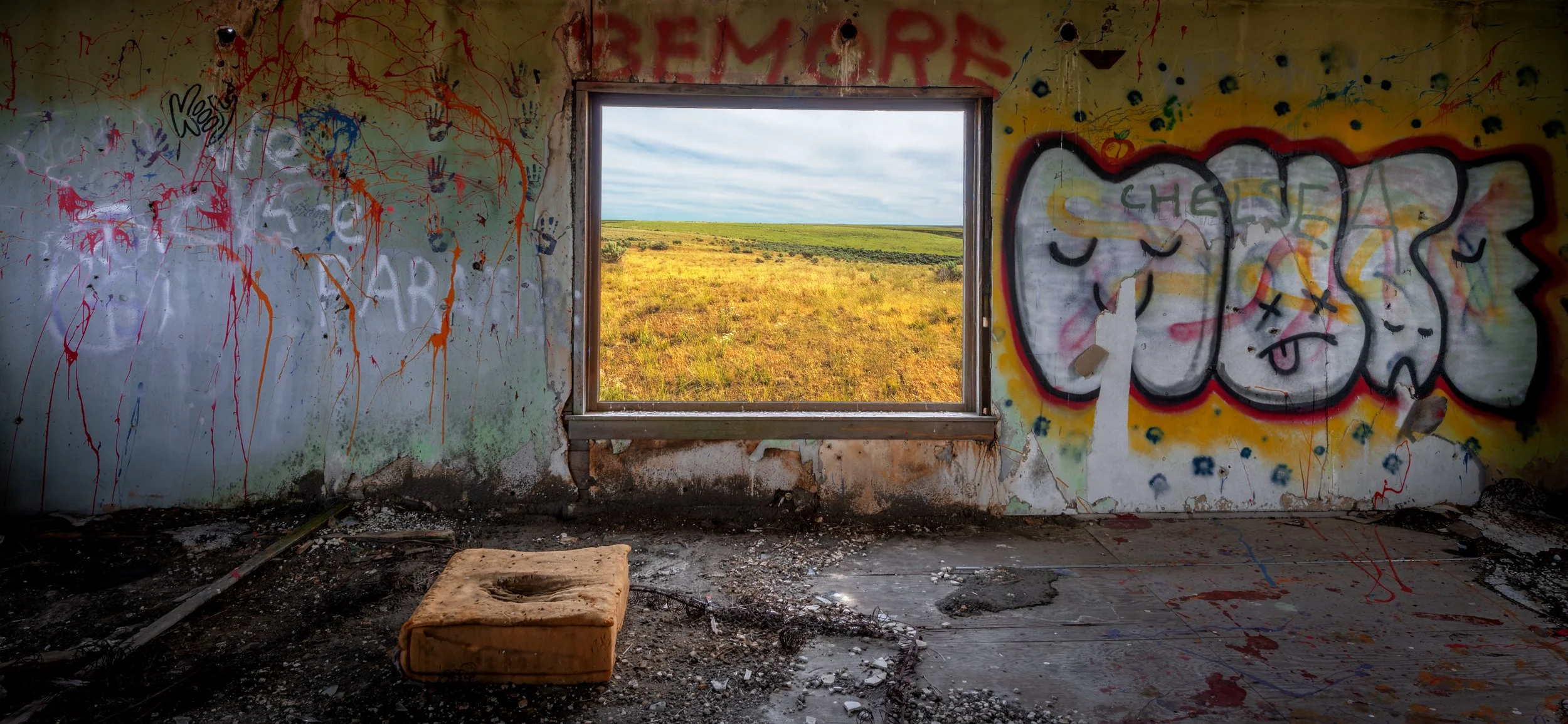The American Dream - Framed Promises & Fading Walls
“I think this divide is the most pressing in our nation’s culture.”
A deeper look at “The American Dream”
Some artworks develop slowly—built over hours of observation, adjustment, waiting.
Others arrive in an instant, fully formed.
This was the latter.
I was driving through central Oregon farmland, a middle-of-nowhere road surrounded by dry fields and sky, when I pulled off near a decaying structure. The walls were covered in graffiti, layers of handprints and cryptic phrases. The roof was partially collapsed. It was chaos—but not without its own kind of order. A visual language had developed there, like sediment from a culture both loud and fading.
Photograph of my friend, Roman, through the windows
And then I turned.
There it was.
A picture window, cleanly framed, showing nothing but open land and soft light beyond it. In front of it: a single sunken cushion on the ground, and the phrase “BE MORE” scrawled faintly above. It hit me hard and fast. A photograph of the American Dream.
That phrase carries so much weight. We grow up hearing it. We build our lives in orbit around it. But this scene made me ask:
Where are we, really, in relation to the dream we’ve been promised?
Because here was a perfectly composed metaphor. A ruined room. A window to peace. A seat left behind. And silence.
It’s easy to imagine many meanings here. Some people will see hope: the dream is still visible. Others will see irony: a dream so close, yet unreachable. Still others might see a kind of resignation. The dream doesn’t live in a house anymore. It’s just an idea—framed but distant.
And then there’s the graffiti.
On the left: “Mute.” A single word that speaks volumes. I think of all the voices today that feel silenced—not just politically, but socially, culturally, economically. Urban voices that drown out rural ones. Rural voices dismissed as out of touch. Suburbs caught in the middle. I think about how loud everything is right now, and how little is really being heard.
On the right: “We Are Paramore.” At first, I laughed at the randomness. But then the lyric came to mind: “We are broken.” And just like that, it wasn’t random at all.
This is not just an abandoned house photograph.
It’s a frame for reflection. A question about belonging, progress, and loss.
I didn’t move anything in the scene. Didn’t step past that cushion. This had already become its own work of art—a layered collaboration between vandals, weather, time, and truth. I knew my role was simply to bear witness. To frame the frame. To give it space to speak.
The American Dream isn’t a clear answer. It’s a provocation.
A question framed in light.
A seat left empty.
And maybe a challenge to see things as they really are before we decide where to go next.
Explore the Piece
The American Dream is now available in my portfolio as a single edition, one of one, fine art print.
➡️ View The Art Work
Bonus: Behind the Lens
I also captured these two black-and-white images from that day—moments before and after this piece revealed itself.
They feel like a record of witnessing, of wandering, of what the Dream looks like from the outside.
Where was The American Dream photograph taken?
In an abandoned building off a backroad in central Oregon farmland.
What does the artwork represent?
It’s a symbolic fine art photograph reflecting on the American Dream—its promise, its distance, and our cultural relationship to it today.


































